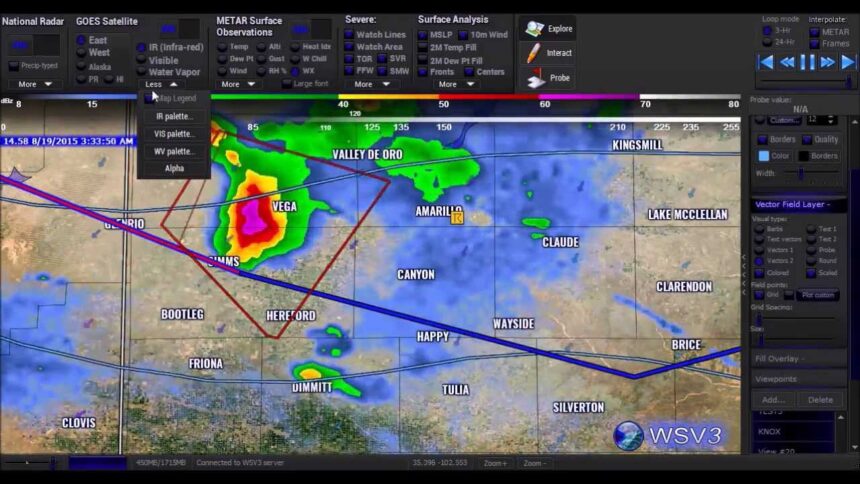The weather has an impact on our routines, affecting activities and travel plans. Although we can’t change the weather itself, advancements in technology have enabled us to anticipate and get ready for weather situations. Weather prediction software has become an asset in enhancing safety by using data and sophisticated algorithms to empower individuals and organizations to make well-informed decisions and reduce risks related to severe weather events. In this post, we will delve into how weather prediction software transforms safety by facilitating better readiness and response strategies.
1. Early Alerts and Notifications:
Receiving alerts during weather occurrences like hurricanes, tornadoes, or snowstorms can be crucial for saving lives. Weather prediction software plays a key role in forecasting these events days or weeks in advance, giving authorities enough time to issue warnings and evacuation directives to the public. By gathering real-time data from satellites, weather stations, and radars, this software analyzes patterns effectively to predict dangers accurately.
2. Enhanced Emergency Preparedness:
Weather prediction software assists emergency management agencies in enhancing their planning procedures by providing information on conditions.
This information helps them determine the resources needed, evaluate dangers, pinpoint evacuation areas accurately, and create effective backup plans for different severe weather scenarios.
3. Response Coordination Efficiency:
In times of bad weather or natural disasters, such as floods or wildfires, seamless coordination among response agencies is crucial to minimize damage and save lives. Weather prediction tools aid in streamlining coordination by consolidating real-time weather data for decision-making across agencies involved in disaster response efforts.
4. Impact on Transportation Safety:
Weather conditions play a significant role in transportation safety across all modes – air travel can be affected by airport closures during snowstorms or thunderstorms; road travel faces risks from limited visibility caused by foggy or stormy conditions; maritime operations encounter challenges like rough seas during storms. Weather prediction tools offer timely updates to transportation authorities, enabling them to make informed decisions regarding service disruptions or adjustments to ensure the safety of passengers and crew members.
5. Resilience of Power Grids:
Severe weather events can impact the power grid, leading to blackouts that affect communities and disrupt services. Weather prediction tools assist utility companies in predicting high-risk areas for weather conditions such as strong winds, ice storms, or lightning strikes.
Utility companies can strategically position resources in advance by identifying areas of concern and mobilizing repair teams preemptively. This proactive approach helps minimize downtime and strengthens the power grid’s resilience.
6. Agriculture & Food Security:
The agricultural sector is deeply influenced by weather patterns. Unforeseeable conditions such as droughts, excessive rainfall, or sudden temperature changes can harm crops and significantly reduce yields. Weather forecasting tools offer farmers insights into weather patterns, enabling them to optimize irrigation schedules, implement effective pest control measures, and safeguard their crops from adverse weather conditions. This increased predictability contributes to enhanced food security for communities.
7. Assisting Insurance Planning:
Insurance companies face risks from weather events that result in a surge of property damage claims. Weather prediction software allows insurers to accurately assess the likelihood of events when determining premiums and devising risk management strategies. By integrating past data on weather incidents in specific regions into their models, insurers can design policies tailored to different weather-related risks.
8. Enhancing Outdoor Event Planning:
Weather prediction software also plays a role in organizing events by furnishing organizers with precise weather forecasts. Whether it’s a music festival, sports event, or outdoor wedding, knowing the weather conditions is crucial for organizers to make well-informed decisions regarding scheduling, setup, and adjustments to ensure the safety and comfort of attendees. Weather prediction software enables event planners to predict disruptions such as rain, strong winds, or extreme temperatures and make contingency plans.
Conclusion
From alerts and enhanced emergency preparedness to improved public safety measures, weather prediction software has transformed the way we approach weather-related challenges. This cutting-edge technology delivers weather forecasts, empowering individuals, organizations, and governments to make choices when faced with adverse weather conditions. By harnessing real-time data and advanced algorithms, weather prediction software facilitates readiness and response strategies across sectors.
The impact of weather prediction software extends beyond safety to include transportation security, power grid resilience, agricultural management practices, outdoor event coordination, public health readiness efforts, and even insurance preparation. By utilizing the weather information provided by this software toolset, authorities can improve collaboration among response agencies in emergencies, optimize resource allocation during crises, safeguard crops from environmental conditions, ensure the well-being of travelers using different modes of transportation, and reduce property damage risks for insurers.






